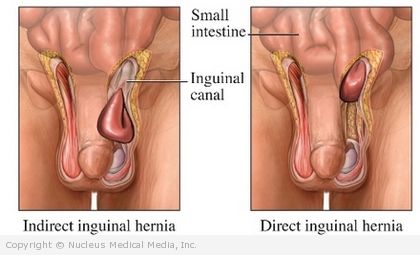(Hernia, Groin—Adult; Hernia, Inguinal—Adult; Inguinal Hernia—Adult)
Groin Hernia – Definition
A groin hernia is an external bulge in the groin area that contains fat, connective tissue, and/or a portion of intestine. There are two main types:
- Inguinal hernia — occurs when there is a weak spot in the area where the abdomen meets the thigh on both sides (most common type)
- Femoral hernia — occurs less frequently, located in the upper thigh
A groin hernia that pushes through the abdominal wall can trap a section of intestine. This can lead to an emergency where the intestine is blocked or strangled.
Groin Hernia – Causes
Anything that causes weakness or tears in the abdominal wall can cause a groin hernia, including:
- Defects at birth
- Prolonged wear and tear (eg, lifting, straining, or coughing)
- Age-related weakness of the abdominal wall
- History of previous surgery in the area
Groin Hernia – Risk Factors
A risk factor is something that increases your chance of getting a disease or condition. Risk factors include:
- Advancing age
- Sex: male (Groin hernias are about 10 times more common in men. Femoral hernias are more common in women.)
- Vigorous physical activity such as occurs in sports like football and rugby
- Increased pressure within the abdominal cavity due to:
- Lifting heavy objects
- Straining to urinate or pass stools
- Severe or prolonged coughing
- Obesity
- Pregnancy
Groin Hernia – Symptoms
Symptoms include:
- A bulge in the groin area when standing or straining
- Pain in the groin area when straining
- A bulge that may extend into the scrotum in men
- Pain, a heavy feeling, or discomfort in the groin (Sometimes there is no pain.)
More serious symptoms may need emergency care:
- Severe pain in the groin or abdomen
- Fever
- Rapid heart beat
- Abdominal swelling
- Nausea
- Vomiting
Groin Hernia – Diagnosis
The doctor will ask about your symptoms and medical history, and perform a physical exam. In some cases, you may have a CT scan or ultrasound.
Groin Hernia – Treatment
Most inguinal hernias require surgery. If it is a small hernia that can be pushed back into place, an external pad (called a truss) may be worn to provide support. Surgery is usually still needed at some point.
After surgery, hernias sometimes return, either on the same side or the opposite side. Hernia repair can cause pain and disrupt your quality of life, but these complications are rare.
Surgeries include:
- Herniorrhaphy — to repair the defect in the abdominal wall
- Hernioplasty — to reinforce the weak area with steel mesh or wire
- Bowel resection — to remove a section of the intestine, may be used when part of the intestine becomes twisted or blocked or turns gangrenous and dies
- Laparoscopic hernia repair — done through several tiny incisions in the groin or abdomen, recovery may be faster
Groin Hernia – Prevention
The following strategies may help to prevent a groin hernia:
- If you are overweight, lose weight.
- Exercise regularly to keep abdominal muscles strong.
- Warm up before exercising to avoid straining your muscles.
- Learn to lift properly. Ask for help with heavy weights.
- Wear a protective belt when lifting heavy weights or moving heavy objects.
- Early management of groin pain in athletes may reduce the risk of a hernia forming.
- Eat more fiber to prevent constipation.
- Stop smoking, especially if you have a chronic cough.
- Talk to your doctor if you:
- Strain when passing stools or urine
- Cough or sneeze a lot

